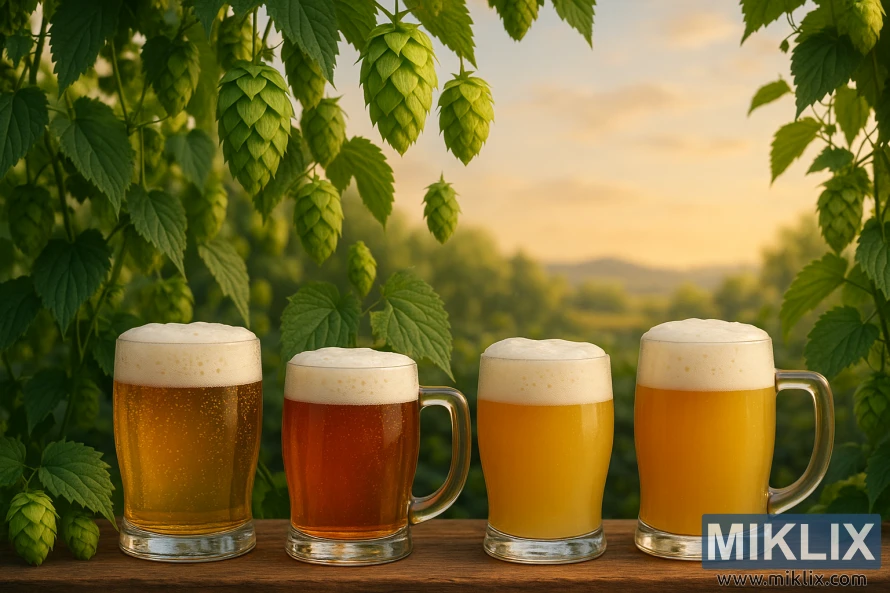Image: Topaz Hops in IPA Styles
Published: August 6, 2025 at 5:00:04 PM UTC
Last updated: September 27, 2025 at 9:10:01 AM UTC
A display of IPA styles—golden, amber, and hazy—set with vibrant hop cones and rolling hills, showcasing the flavor versatility of Topaz hops in brewing.
The image unfolds like a celebration of hops and their transformative journey from bine to glass, a carefully composed tableau that bridges the lushness of agriculture with the artistry of brewing. In the immediate foreground, four stout mugs brimming with IPAs of various expressions line a rustic wooden surface. Each beer has its own identity: one glows with a golden brilliance, effervescent and crystal-clear, its carbonation rising steadily beneath a firm, pillowy head of foam; another wears a deeper amber hue, almost copper, suggesting malt complexity intertwined with the assertive bitterness of hops; the third radiates with the haze of unfiltered juice, its creamy crown promising a symphony of tropical and citrus flavors; while the last, a slightly lighter but equally opaque hazy IPA, seems to revel in its cloudiness, embodying the modern preference for full-bodied, hop-saturated brews. These mugs, with their sturdy handles and thick glass, are not merely vessels but symbols of conviviality, each one inviting the viewer to lift, sip, and savor the craft contained within.
Just above and behind the beers, a curtain of hop bines cascades into view, their leaves wide and veined, their cones plump and verdant. The cones hang like lanterns, clustered in abundance, their papery bracts catching the soft golden light of what appears to be a late summer evening. Each hop cone tells its own story, a narrative of resinous lupulin hidden within, bursting with essential oils that will soon define the very aromas and flavors of the beers below. This juxtaposition of raw ingredient and finished product emphasizes the inseparable bond between field and brewery, a visual reminder that without these hops—alive, aromatic, and delicately complex—there could be no IPA. The way the light filters through the greenery adds depth and warmth, as though nature itself is leaning in to celebrate its role in the process.
In the distance, the landscape stretches toward rolling hills softened by the glow of golden hour. The horizon is gentle, punctuated by trees that dissolve into the haze of late-day sun. The sky above is painted in tones of peach and amber, echoing the very colors found in the glasses below, unifying the natural world with the human craft it inspires. The blurred backdrop offers serenity, but it also grounds the scene in a real place—perhaps a hop-growing region where the cycle of cultivation, harvest, and brewing is a rhythm as old as the land itself. The hills provide a sense of timelessness, as though generations of brewers and farmers have stood in similar fields, marveling at the miracle of transformation that turns humble green cones into liquid gold.
The composition balances abundance with intimacy. On one hand, the viewer is offered the lush vitality of nature, hops clustered in their prime, rich with potential. On the other, there is the immediate, tactile satisfaction of beer poured and ready to drink, each glass representing a distinct interpretation of the brewer’s vision. The IPAs stand not only as individual styles but as a collective testament to the versatility of Topaz hops, whose flavor spectrum ranges from resinous pine and earthy spice to bright tropical fruit and zesty citrus. The variety in the lineup shows how this hop can lend itself to multiple approaches: crisp and bitter in a classic West Coast IPA, juicy and aromatic in a hazy New England variant, or complex and balanced in something amber-hued and malt-forward.
What emerges from the image is a narrative of harmony, where agriculture, artistry, and tradition converge. The hops above are not just decorative elements—they are guardians and givers, bestowing their gifts to the mugs below. The beers, in turn, are ambassadors of their origin, carrying the memory of sunlit fields, attentive cultivation, and the brewer’s hand. Together, the elements craft a vision of IPA not as a single beer but as a spectrum, a language of flavor spoken in countless dialects yet united by a shared vocabulary of hops. The atmosphere is celebratory but not ostentatious, inviting but not rushed, suggesting that the best way to honor this diversity is to pause, sip deeply, and appreciate the journey from bine to glass.
The image is related to: Hops in Beer Brewing: Topaz

